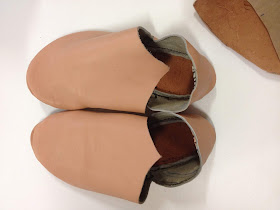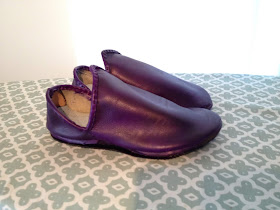In late 2017 a local Laurel came to teach us about turnshoe making. I really wanted to have a try at making my own shoes, and decided to make a pair loosely inspired by this extant sixteenth century piece:
“Spanish decorative shoe (1590-1600) belonging to Bayerischen National Museum, Munchen. Source : Durian-Ress, Schuhe, 1992″ at https://www.pinterest.com.au/pin/390546598929865501/
I had some difficulties with the pattern, so simplified it a lot to make a pull on shoe. I wasn't sure how the slashing would impact on working the leather, so I decided to make a slashed pair when I had more experience.
My friend Master William gave me some firm leather and helped me design a pattern from my foot. He also helped me with a lot of the cutting because the sole leather was quite firm and the cutting was hard going.
The front and back upper pieces were sewn to the sole by hand. I used an awl to make the holes and a saddle stitch to stitch them together.
A small strip of leather was also sewn in to reduce the chance of water coming through and wetting my feet and rotting the leather
Making the stitch holes with the awl
My finished, inside out shoe
My friend added an extra support piece inside the heel for extra strength
We wet the shoes and turned them inside out
And they looked so much better right side out! The turning was not very difficult because the toes are quite round
I decided to sew a decorative strip of leather around the foot opening for extra durability
We added some commercially made soles because I get clumsy when I get tired and I don't want to slip on the leather soles
I dyed the shoes purple with leather dye
I was very pleased with how the shoes turned out. Not bad for a first try - but that is mainly due to the skill and patience of my friend Master William. I would like to try another pair, but have to wait for my wrist injury to heal as I found the process very hard on the hands.
This was a fun and challenging project and I would recommend anyone thinking about it to give it a go.
Many thanks to Master William for giving up so many months to help so many in the Barony with this project, and for his generous donations of materials.


















No comments:
Post a Comment